|
Limitar tu búsqueda
[+–] Compilador o editor
[+–] Editorial
[+–] Fecha
[+–] Formato
[+–] Idioma
[+–] Tipo de documento
[+–] Tipo de recurso
|

|
|
Academic performance of public university students in Argentina
Designing educational policies under limited budgets requires a thorough analysis of the impact of alternative factors on student performance. This work aims at providing an analysis of the relationship between university performance and its explanatory factors. The analysis Will focus on the Argentinean case, using the 1994 Census of Students in National Universities, which includes data on all...
|
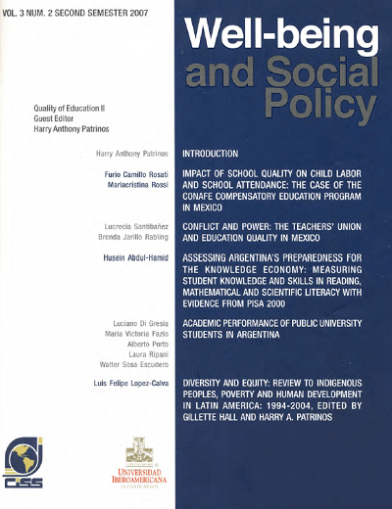
|
|
|
|

|
|
Assessing Argentina's preparedness for the knowledge economy: measuring student knowledge and skills in reading, mathematical and scientific literacy with evidence from PISA 2000
The results of 2000 study of the Programme for International Student Assessment (PISA) show that while Argentinean students performed similar to their peers in most other Latin American countries, they lagged behind all OECD and most of other participating countries. Attention needs to be given to further master the reading, math and science skills that are needed for a knowledge economy; and...
|
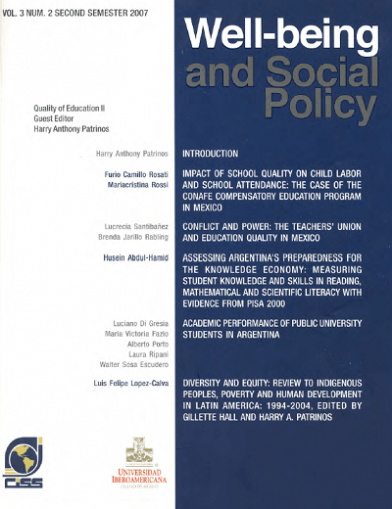
|
|
|
|

|
|
Conflict and power: the teachers' union and education quality in Mexico
The teachers union in Mexico, or Sindicato Nacional de Trabajadores de la Educación (SNTE) represents over 1 million members and is the largest in Latin America. This study uses data from the national student tests administered by the Instituto Nacional para la Evaluación de la Educación (INEE), along with data from the Mexican Ministry of Education and other sources, to investigate the...
|
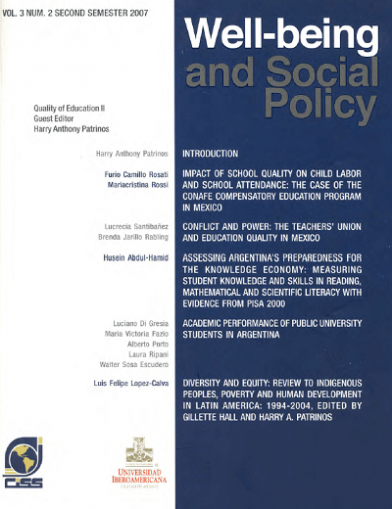
|
|
|
|

|
|
Impact of school quality on child labor and school attendance: the case of the CONAFE compensatory education program in Mexico
This paper focuses on the impact that two different types of policy interventions, namely enhancing school quality and contingent cash transfers, have on child labor and school attendance in Mexico. While there are many studies on the impact of Oportunidades on schooling outcomes, little evidence is available on whether school quality programs such as CONAFE also reduce child labor and help keep...
|

|
|
|
|

|
|
Reseña del libro. Empleo, trabajo y desigualdades en salud: una visión global. Joan Benach, Charles Muntaner, Orielle Solar, Vilma Santana y Michael Quinlan
Este interesante libro explora la relación entre las condiciones de empleo y los resultados de salud. Los autores proporcionan un marco conceptual para ilustrar los canales por los que se afectan y determinan los resultados de salud; este marco incluye variables individuales y agregadas, como las condiciones económicas, políticas y ambientales. El libro incluye además casos de estudio que...
|

|
|
|
|

|
|
Book review. Improving the quality of education in Mexico: Positions and proposals, edited by Francisco Miranda, Harry Patrinos y Ángel López
This book gathers analyses performed by several authors on policies considered appropriate by the World Bank to enhance the quality of basic education provided in Mexico, in particular, education received by majority sectors in our society (World Bank: 2005).
|

|
|
|
|

|
|
"La Nocturna": study of educational choice in Colombia
This study uses data from Colombia’s 2003 Encuesta de Calidad de Vida to examine how well do electricity strata (proxy for socioeconomic status) explain the choice decision for type of institution and session attended. In the model of choice by type – private vs. public universities – I find that as the electricity strata increases, the marginal probability of enrolling in a public university...
|

|
|
|
|

|
|
Exploring the effects of the school levels reform on access and its quality: the Education Federal Law of Argentina
Over the last decade, Argentina embarked on a broad education reform, the Federal Education Law (LFE), being its main objective to expand access to basic education, mainly, by a new organization of the schooling level structure with the extension of mandatory schooling from 7 to 10 years. The provinces reactions were heterogeneous. We try to evaluate the relationship among the LFE and access and...
|
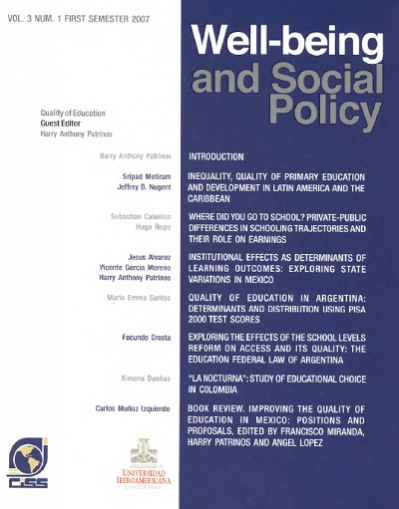
|
|
|
|

|
|
Introduction (about the international conference on "The quality of education in Latin America and the Caribbean")
The Inter-American Conference on Social Security (CISS) and Universidad Iberoamericana (UIA) co-hosted an international conference on "The Quality of Education in Latin America and the Caribbean" in February 2007. The main obj ective of the conference was to examine quality of education in the region, the determinants of learning, policy and program evaluation, and the impact of quality of...
|

|
|
|
|

|
|
Inequality, quality of primary education and development in Latina America and the Caribbean
This paper draws on a political economy model to hypothesize that the quality of education is likely to be lowered by both economic and political inequalities. In particular, we utilize a panel data set across countries and over time to test the applicability of the hypothesis to quality of education indicators at the primary level. Among the four specific indicators of primary education assigned...
|
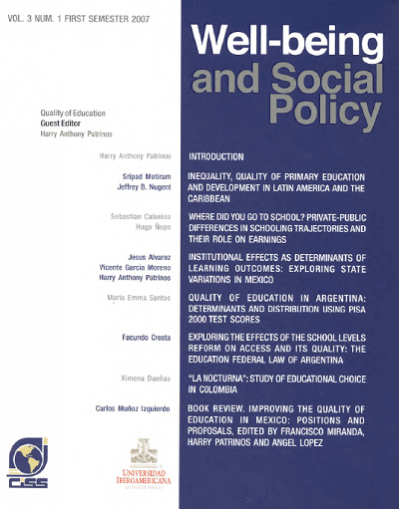
|
|
|
|

|
|
Where did you go to school? Private-public differences in schooling trajectories and their role of earnings
The private provision of educational services has been representing an increasing fraction of the Peruvian schooling system, especially in recent last decades. While there have been many claims about the differences in quality between private and public schools, there is no complete assessment of the different impacts of these two type of providers on the labor markets. This paper is an attempt...
|
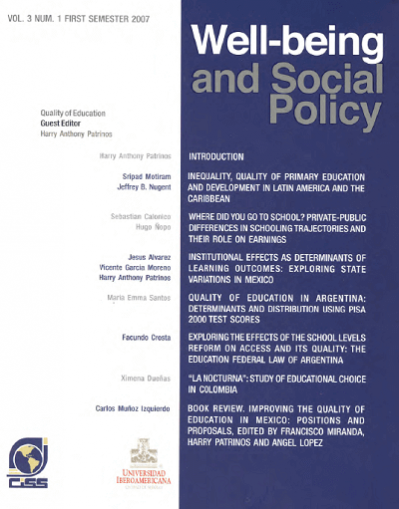
|
|
|
|

|
|
Introducción (sobre los temas que aborda el presente número de la revista)
Las micro y pequeñas empresas (MYPES) son actores centrales para el desarrollo productivo en América Latina por su contribución a la generación de empleo, su participación en el número total de empresas y, en menor medida, su aportación al producto interno bruto. No obstante, su producción está vinculada principalmente al mercado interno y se caracterizan por una creciente brecha de productividad...
|

|
|
|
|

|
|
Inequidades en mortalidad infantil en Colombia: avances y desafíos después de una mayor responsabilidad de las autoridades locales
El objetivo de este documento es analizar la distribución espacial y temporal de la tasa de mortalidad infantil (TMI) a nivel municipal en Colombia antes y después de otorgar una mayor responsabilidad a las municipalidades en la administración de sus sistemas locales de salud. Utilizando técnicas de econometría espacial se encuentra que hay una concentración geográfica de la TMI que persiste en...
|

|
|
|
|

|
|
Quality of education in Argentina: determinants and distribution using PISA 2000 test scores
In this paper we study the determinants and distribution of learning outcomes in Argentina I measured by PISA 2000 reading and math test scores. To do that, we estimate education production functions at the mean of the distribution using survey regressions and at different parts of the score 's distribution with quantile regressions. In terms of educational policy aimed at improving learning...
|

|
|
|
|

|
|
Determinantes y desigualdades socioeconómicas en las condiciones de desnutrición infantil de Sri Lanka
A pesar de los múltiples esfuerzos por mitigar la desnutrición que se han realizado a través de los años, ésta afecta a cientos de miles de niños en Sri Lanka. Es de vital importancia entender los factores determinantes y las desigualdades socioeconómicas en las condiciones de desnutrición para poder concentrar la ayuda en grupos socioeconómicos específicos con objeto de mejorar su estado de...
|
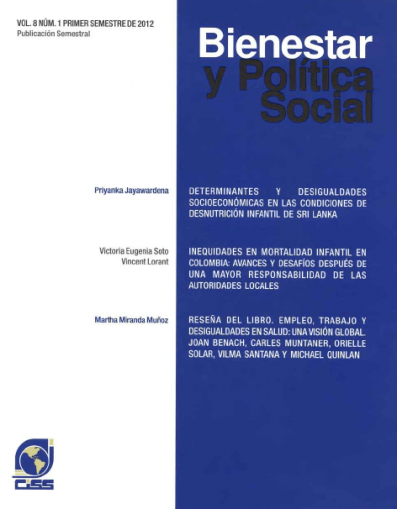
|
|
|
|

|
|
Efectos redistributivos del Programa Nacional de Financiamiento al Microempresario y a la Mujer Rural en México Un estudio con enfoque de género
Se cuantifican los efectos del Programa Nacional de Financiamiento al Microempresarioy a la Mujer Rural (Pronafim) en la generación y redistribución del ingreso en México con perspectiva de género. Para ello, se formula el modelo de multiplicadores contables que recoge endógenamente las relaciones ingreso-gasto entre: 31 sectores económicos; dos tipos de hogares, los encabezados por hombres y...
|

|
|
|
|

|
|
Migración laboral: retos y oportunidades para la protección social
La migración internacional se ha establecido como un fenómeno normal en las sociedades contemporáneas, pero se mantiene una gran deficiencia en la cobertura de la seguridad social hacia los migrantes internacionales. Las cifras de flujos anuales de migración se han estabilizado después de la disminución que ocurrió a partir de la recesión económica de 2007-2009, y hay un acervo grande de familias...
|
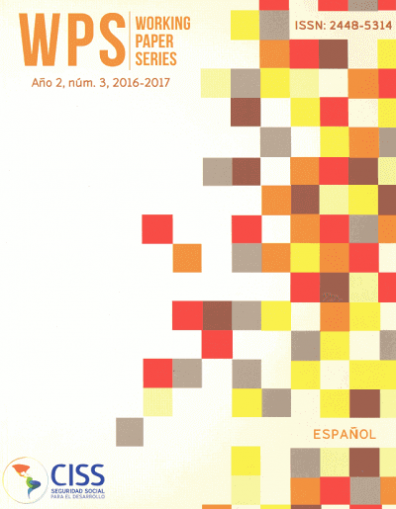
|
|
|
|

|
|
Profesor Emil Schoembaum
Biografía sobre Emil Schoenbaum, personaje destacado en la parte actuarial correspondiente al tema de la seguridad social, por lo que logró altos cargos en diversas instituciones de su país, como el de director general del Instituto General de Pensiones. Padre de la ley checoslovaca de 1924, donde se introduce el seguro de vejez, invalidez y sobrevivientes para los trabajadores...
|

|
|
|
|

|
|
Administración para el éxito a través de la educación
El entusiasmo por las llamadas tecnologías de la información o nuevas tecnologías ha vuelto de uso corriente expresiones como sociedad de la información o sociedad del conocimiento, presentándolas con frecuencia como términos clave para explicar problemas, ofrecer soluciones y pronosticar escenarios que abarcan los más diversos ámbitos de la sociedad. Esto se puede observar en el análisis sobre...
|

|
|
|
|

|
|
Representaciones sociales del envejecimiento en paramédicos mayores de 55 años de un establecimiento de salud pública: desenmascarar la realidad de los funcionarios públicos frente a la jubilación, en el ámbito de la reforma de salud
Uno de los cinco proyectos de ley que conforman la Reforma de Salud lo constituye el denominado "Autoridad Sanitaria y Gestión", que terminó su trámite legislativo el día 21 de enero al ser aprobado por la cámara de diputados y queda en condiciones de ser promulgado como ley. Entre otros aspectos, este proyecto crea establecimientos de salud públicos autogestionados en red. El objetivo de esto es...
|

|
|
|
|
|